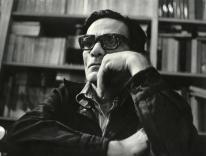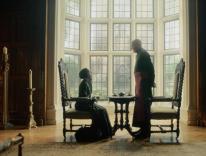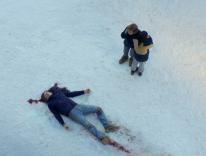I remember Walt Disney’s “True-Life Adventures” of the 1940s and ’50s with little fondness. Indeed, The African Lion, The Living Desert, and all the others bored me to a state of stupefaction. Back then, my idea of exploring frozen tundra was to look into the icebox to see if my sister had eaten all the Popsicles, and the only savannah on my horizon was the front lawn I had to mow. Obviously, my lack of enthusiasm for all nature documentaries testified to my own limitations, not Disney’s.
Well, maybe Disney was to blame, too. For all the Oscars they won, those nature films propped up their often impressive visuals with cute, anthropomorphizing commentary (spoken by Winston Hibler)—“this little eagle has spread his wings, but he’s not quite ready for the Air Force Academy yet”—and even cuter mock-sardonic musical accompaniment—Verdi’s “Anvil Chorus” as a soundtrack for rival male elks clashing horns. Worse still, the editing and narration shaped the action so that the lives of beasts became the success story of one particular lion or beaver, enduring hardships and prevailing over all enemies. When Ernest Thompson Seton wrote (in his classic Wild Animals I Have Known), “The life of a wild animal always has a tragic end,” he was stating an undeniable truth that the Disney documentaries could not abide.
Earth is the first release by Disneynature, the new documentary unit of the Magic Kingdom. It is a repackaging of footage from the BBC/Discovery Channel series Planet Earth. Filmed by artists who love nature and were determined to convey its workings truthfully, the footage was manipulated by editors and writers determined to make it answer to Disney-approved notions of family entertainment.
This would be especially evident if you were nutty enough to sit through Earth with your eyes shut. Then the narration (unctuously intoned by James Earl Jones) would carry you straight back to the days and ways of “True-Life” and Winston Hibler: “This creature [a lynx] is the essence of wilderness”; “Their father’s spirit will live on in the little polar bears’ hearts”; and, when a bird of paradise begins a mating dance, “Get down, baby!” Mother Nature sure is funky. Finally, the film’s epilogue desperately tries to defuse Earth’s candor with an isn’t-nature-eternally-wonderful peroration, accompanied by music that sings of many bright tomorrows. But as long as you go with your eyes open, this movie will open them wider.
It’s difficult to impose a dramatic shape on natural activities, but by concentrating on certain animal groups—elephants, polar bears, rain-forest birds, humpback whales, lions—and following them as they trek for food, the movie takes on a suspenseful momentum: forced along not only by changes of season but also by human interference with nature’s climate, the beasts are racing against their own dwindling strength.
The plight of a family of polar bears is near the core of Earth’s pathos. Deprived by global warming of the ice platforms from which the parents customarily hunt, the bears must travel a great distance to find sustenance. The father (well, we are told he is the father), separated from mother and cubs and feeling his own death at hand, attacks a living wall of walruses in order to get at the walrus pups, who are defended by the tusks and blubber of their elders. In earlier nature films, a baby animal was automatically good, its predator automatically evil, and so we would root for the walruses against the polar bear. But Earth dispenses with that easy sentimentality. By the time we come to the bear’s last stand, we have been with him on his desperate trek and understand his suffering. He doesn’t deserve to die any more than the walrus pups do. In fact, the very word “deserve” has no place outside our species. Nor does the word “tragedy” apply, although when the thwarted bear sinks down to await his end, close to the now quiet and utterly indifferent walruses, I did feel as if I were watching a warrior die beside an eerily uncaring chorus. Again, that was my sentiment-hungry human nature reacting to magnificent imagery. This movie, more than any other documentary I’ve seen, lays before us both the radical innocence and the radical ruthlessness of nature. But since it is a nature illegitimately tampered with by humanity, our awe must be mixed with anger at what we have done.
Earth is packed with sights that may remain with you forever. A wolf chases a caribou but seems to overshoot the mark as it comes in for the kill. Then, as the head curves back to take the fatal bite, we see how precisely the hunter has calibrated its run.
An aerial shot shows us that a starving elephant, having fallen far behind the herd, is heading in the wrong direction to overtake them. Later, lions hungry for elephant prey temporarily accede to a truce in order to share a waterhole. In this case, “truce” is not an anthropomorphic term because we see the instinctive wariness in the eyes of the cats.
BBC documentarians Alastair Fothergill and Mark Linfield have wrought a magnificent movie, even if their achievement is somewhat damaged by Disney’s wrapping job. But it’s easy enough to throw aside the wrapping paper to get at the very valuable gift inside.
What works best in the new Star Trek, J. J. Abrams’s origin-story of how the crew of the Enterprise got together, are the wisecracks and the stunts. They will work just as well in DVD format, and there’s something sad about that. Abrams, the TV wizard whose Lost has a devoted following, knows what to do with a big budget, yet he has a small-screen visual style. For the dialogue scenes he slams his camera close to the speaker’s face, and he hurls us into fights and explosions without building the suspense that a more artful director would strive for. Nothing interesting is done with the depth of the screen or its edges. This may seem appropriate for a movie grounded in a TV series, but the series didn’t attract its (eventually) huge audience with spectacle or stunts.
On television, Star Trek was slow and visually clunky, but the very lack of pizzazz focused the viewer’s attention on the scripts, with their futuristic problems and conjectures. Gene Roddenberry, Trek’s creator, and many of his co-writers came out of the same sci-fi generation that included Robert Heinlein, A. E. van Vogt, James Blish, and all those classic contributors to Astounding Stories magazine whose forte was speculation, not sensation. In the Abrams movie outer space is just a background for fireworks. The concepts of time travel and alternate worlds are broached, but they aren’t presented lucidly. They merely goose the plot along.
Abrams is a clever writer (he worked on the script with Roberto Orci and Alex Kurtzman), and he has come up with funny origin-riffs on the characters, using their youth to inflate their familiar qualities. This young Kirk, played by Chris Pine, is a macho maniac, and the whole universe is his frat house. Pine plays the comedy of testosterone to the hilt. As Spock, played by Zachary Quinto, broods on his origins and destiny, his demi-Vulcan calm takes on a Hamlet-like quality. Quinto has drawn the unfair criticism of being dull in comparison with Pine, but I found him admirably centered, with suggestions of complexity behind the handsome face and the pointy ears. Simon Pegg’s Scotty is a hilarious über-nerd finding his heaven at the Enterprise control panel, while Zoë Saldaña’s Uhura is youthfully smart and sexy—as Nichelle Nichols was maturely smart and sexy in the television series. But to think that she has sexual designs on Spock! And that he, her mentor, responds! Such political incorrectness from Star Trek!
Please email comments to [email protected] and join the conversation on our Facebook page.
Share
Previous Story
More Being
Next Story
Domestic Disputes


